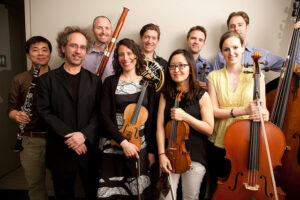The BBC News captures the spirit of “A Toronto Symphony”. Watch below:
Category Archives: Video
Peter Oundjian on “A Toronto Symphony”
Workshop with Toronto Kids (Video)
Check out this video posted by the Toronto Symphony about Tod Machover’s workshop with Toronto city school children. We’re blown away by how the kids speak about their composing concepts.
Opening chords with Toronto Symphony Youth Orchestra
During September’s Culture Days, composer Tod Machover met with the talented players of the Toronto Symphony Youth Orchestra to introduce “A Toronto Symphony” and lead them in a collaborative exercise using the opening chord progression. Here’s a taste:
Using Hyperscore for “A Toronto Symphony”
Over the summer, a couple dozen Toronto music teachers convened workshops to develop an exciting new music curriculum incorporating Hyperscore, a music composition software that uses a graphical annotation interface enabling anyone to express themselves creatively through music. Here’s Tod Machover explaining how the curriculum is now being taught to several hundred Toronto school kids.
From Tod Machover:
Now that I’ve collected a range of sounds from you all, we’re ready to begin using Hyperscore to create music!
Hyperscore uses lines and color as opposed to typical musical notation to express musical ideas so that people of all ranges of skills and musical training can compose. Over the past months, we have had the opportunity to work with teachers from the Toronto School District to create curriculum that will encourage students to compose with Hyperscore. This spans across middle and high school levels, and we’re hoping to connect younger and older students to collaborate on the same pieces. Younger students can create melodies that older students can combine into compositions and send back to the middle school for reflection and thoughts on improvement. Eventually, these projects will become part of the Toronto Symphony project.
Don’t worry—if you aren’t a current student, I still want you to be involved. This is the link to Hyperscore: http://hyperscore.com. I will be sending out ideas for sections of the final piece or small Hyperscore fragments for you to work on alone and with the other participants of the project so we can reflect together on the best melodies and short compositions for the final piece. Let’s get started!
Yours, Tod
If you’d like to try your hand at composing with Hyperscore, the company is making the software available to “A Toronto Symphony” participants at a discount. Please email june@harmonylinemusic.com to receive the discount code.
Sounds of Toronto – Bicycle Music Festival (Video)
The sounds made by this friendly mob of two-wheeled musicians and revelers will make you all kinds of happy! Do they make you want to compose your own music?
How We’ll Use Your Sounds of Toronto
A new message from Tod Machover –
Over the past few months, you have been collecting sounds from all over Toronto, and now we’re nearing the time for me to explain how these sounds will form the concerto.
So far, I’ve thought of a couple of ways to incorporate these sounds into the final piece. First, it’s possible that the sounds you recorded and sent in will be directly incorporated into the piece. However, this has been done before, such as by the revolutionary composer John Cage. What will be more common for this project and also a much newer musical idea is the practice of taking these sounds and playing them with traditional instruments found in the Toronto Symphony Orchestra. By breaking down the sounds and interpreting them musically together, we’ll be able to closely relate these urban sounds in a much more classical way.
I experimented with this before while composing another opera of mine, “Skellig”, but accomplishing this transformation of sounds on this scale will require quite a lot of playing around with music and reflecting on what does and does not work. This is where you come in, as your help in listening to and tweaking these interpretations will be necessary in order to attain the most accurate reflections of the city. I can’t wait to move forward on the project with you and bring these collections of sounds to life.
Yours, Tod
Click here to listen to excerpts from the opera “Skellig.”
“Launch Music” for A Toronto Symphony (Part 2)
Continued from Part 1…
With chords in hand, I contacted Jeff Beecher, bass player in the Toronto Symphony Orchestra and co-chair of the musician’s committee, to see if he and some of his colleagues would be interested in working with this initial chord progression for our first collaboration. Jeff was willing, found eight other players who also wanted to participate (2 violins, viola, cello, Jeff on bass, bassoon, french horn and clarinet), and we were off.
I sent them the chord progression and asked if they would augment and modify what I had written, by adding new chords, writing melodies to my chords, and/or proposing sounds suggested by my chords. All eight of them got back to me within a few days with a wealth of remarkable music including quirky melodies, jaunty and sometimes jagged rhythms, and some quite unusual sounds. It was a very pleasant surprise that they responded, and even a better surprise that what they send back was so interesting and so unexpected. Continue reading
“Launch Music” for A Toronto Symphony (Part 1)
To officially launch our A Toronto Symphony collaboration, I created a series of chords last month to serve as a kind of “genetic” code for the project, and also to serve as material that we could share back-and-forth to modify and to make new things. Chord progressions are great because they are both simple – a kind of musical backbone or skeleton – yet complex enough to truly tell a story. Just think of the chords in a classic piece by The Beatles like “Michelle”, or the way Bach squeezes a universe of expression out of his seemingly simple 4-part Chorales.
I have always enjoyed composing harmonic progressions, and the one I have started for A Toronto Symphony is typical of the way I work (see score at right). There is a strong melody line that helps to shape how each chord moves to the next, and how the whole line together creates a story. In my music, the bass (lowest) line is equally important…and of course I care about the rest of the notes too. In addition, this chord progression starts and ends simply, but moves in waves, zigzagging from simple/familiar to complex/strange chords, from notes bunched near the center of the keyboard to those spreading from low to high, and from chords which feel restful and resolved to those that seem dense and tense. Sometimes the movement from one chord to the next feels fluid and natural, sometimes surprising. I have tweaked this all fairly carefully, so that the whole progression feels pleasing and complete but also has much variety and potential for further development.
You can hear how the first section of the chord progression sounds by listening at 9:10 in the video below, from my ideacity 2012 talk:
Feel free to download the score and play around with it yourself. Try it on an instrument, add your own melodies, rhythms and variations, and share it back. I’d love to hear what you do with it!
Harmonically yours,
Tod
Coming soon, Part 2
Your Sounds: The Subway Chime
What’s your signature Sound of Toronto? Business consultant and visual artist Derek Wong says one sound in particular is most memorable: the three-note melody that plays when the TTC subway doors close. “It actually drives me crazy,” he says. Watch:


